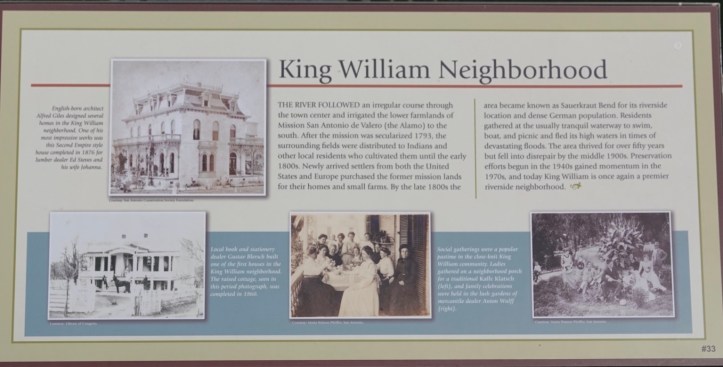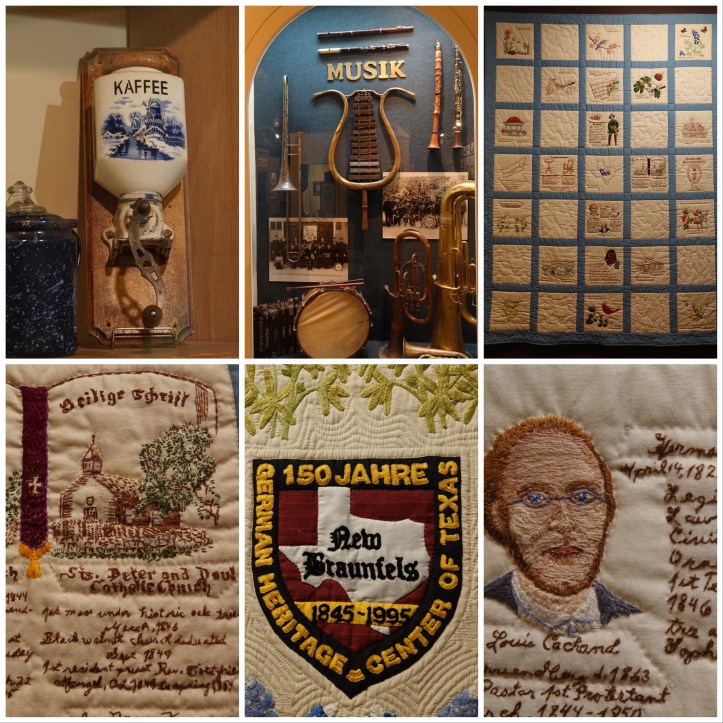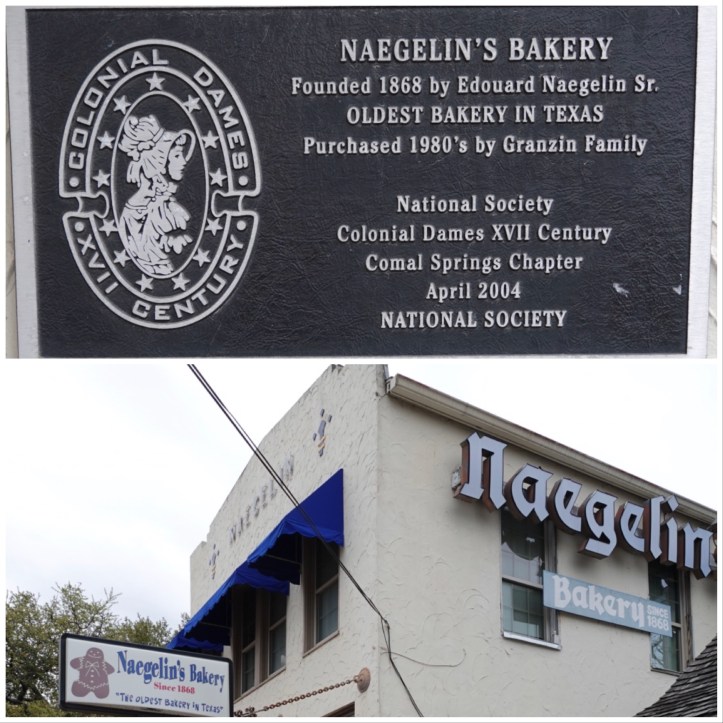Good grief…. they’re everywhere! (or should I say “we”?)
Sam, a delightful Italian-American gentleman we met on our December cruise, told us (perhaps by way of “explaining” his lovely German-born wife) that people with German heritage are the largest ethnicity in the United States. I found that really surprising, so naturally we had to Google it. Sam was absolutely right! The U. S. Census Bureau says that more Americans identify as German or African American than any other groups, at 14.7 and 12.3 percent respectively. You can check out the rest of the data here if you’re interested: https://www.worldatlas.com/articles/largest-ethnic-groups-and-nationalities-in-the-united-states.html
Specific to Texas, there was a large influx of Germans as early as the 1830’s due to the political and economic conditions that eventually led to the Revolutions of 1848 in Europe. People who claim German ancestry are still the third largest ethnic group in the state.
This spring we are living in the Judson Candy Factory Lofts in the Historic King William District of San Antonio, a neighbourhood on a curve in the San Antonio River named after Kaiser Wilhelm of Prussia in recognition of the predominantly German immigrants – merchants and farmers – who settled in the area. For many years it was colloquially known as “Sauerkraut Bend”.

We’ve eaten potato pancakes with applesauce at Schilo’s, San Antonio’s oldest restaurant, established by a German family in 1917. Their home-made root beer recipe (created during Prohibition) is justifiably famous, but their potato pancakes, while authentic, can’t rival what my dad used to fry up for us.
Just a couple of blocks from our loft we discovered the Beethoven Männerchor Halle and Garten (hall and “garden” … as in beer-garden), home of the Beethoven Männerchor (men’s choir), founded in February of 1867 as an offshoot of an earlier German choir founded around 1847 that broke up when many of its members left to fight in the American Civil War. So, while we’re here, why not take the opportunity to sign up for the conversational German classes offered at the hall? It’s the first time I’ve been able to convince Ted to try to pick up a bit of German language. I think Hildegard, my friend and German teacher extraordinaire, would be pleased with us. Ted is taking the beginner classes and I’m taking the intermediate…. and hopefully we’ll both be better prepared for my German cousins’ visit in June, as well as our trip to Germany in December.
The teacher is an 80+ year old professor emeritus from the University of Texas at San Antonio, who teaches by anecdote. We’re getting more language theory and less conversation than we might have hoped, but I’m never going to forget how to describe the appearance and position of a briefcase (his favourite prop)!
After my first class, while waiting for Ted to finish his, I headed into the Männerchor for a beer. (The choir is such a significant part of this community that they refer to the bar itself by the choir’s name.) Since Tuesdays are both choir practice and language class nights, the bar was packed. Not much German was being spoken, except by the men heading in to practice, but the room was full of conversation. All the people at the table I was invited to join were long-time San Antonians, but only one of them was of German heritage; the others had Mexican, English, and Irish roots – yet each of them was somehow involved with the German club. One was taking German classes with me, one helped with social events, one sings in the women’s choir, and another was the parent of a child in the youth choir. Their common interest is keeping the heritage of the King William District alive…. oh, and drinking German beer.
Speaking of German beer, it’s a really big thing here, with several kinds available in pretty much every restaurant and pub alongside the Texan brews. While most of the German beers are imported, within a short walk from our condo is Kunstler Brewing, where a German woman and her Texan husband are creating German-style craft beers and serving them with German/Texan fusion food – think freshly baked pretzels with sides of German Obatzda (a Bavarian specialty: 2/3 Camembert and 1/3 sweet butter) and Texan pimento cheeses, or BahnMi style bratwurst topped with jalapeños.
Probably the best example of German heritage being preserved in Texas is the community of New Braunfels, which was established not far north of San Antonio in 1845 by Prince Carl of Solms-Braunfels, and still prides itself on its historic district, German restaurants and beer halls, and Oktoberfest celebrations. Many present day Germans have a fascination with cowboy culture, cowboy hats, cowboy boots, and bolo ties; clearly the “wild west” has been a draw for a long time. It goes almost without saying that I dragged Ted to New Braunfels to check it out. Okay, so it’s also the location of the nearest Belk department store, but I’m sticking to my story of going there to check out the German connection.
The best way to delve into a small town’s history is to visit their museum, and the Sophienburg Museum in New Braunfels is exceptional.

As we walked around town, I felt drawn to Naegelin’s Bakery, the oldest continuously operating bakery in Texas, founded by Edouard Naegelin in 1868, after he returned from fighting in the Civil War. He was one of the immigrants who came to Texas in 1844 along with others from Alsace Lorraine. The bakery was family owned until the 1980’s when it was sold to the Granzins, another family with German ancestry. While the bakery now makes a number of American style items, and even bakes tortillas, it is still the community’s source for hearty German breads, kolaches, flaky fruit strudels, German cookies (pfeffernüsse, lebkuchen, and springerle), fresh yeast donuts, German pretzels, and beautiful cakes. We’re no longer big dessert eaters, but nonetheless a slice each of apple and peach strudel, and one each of their apricot and lemon kolaches came back to the condo with us to be enjoyed later (neither of which, after tasting, could hold a candle to my grandmother’s versions), along with a loaf of freshly baked rye bread (that was perfection).

New Braunfels is also the home of the original Schlitterbahn (“sled/toboggan run”) waterpark, 40 years old and employing 2000 people. Back in 1979 it was considered the world’s first waterpark. It also claims the world’s first wave river, and the world’s first uphill water coaster. The Henry family built six more parks and two resorts in Texas, with the original park and another in Galveston sold just last year to Cedar Fair Entertainment for $261 million. We missed the March 7th park opening by a couple of days. Sure, that’s the ONLY thing that kept us from hurtling through the twisting tubes of the Master Blaster.

We took a moment to stop at New Braunfels oldest church: First Protestant, founded in 1845. The current building dates to 1875. Like most German protestant churches, it has plain lines and a simple interior, but with beautiful stained glass windows. Unique to this church is the modern outdoor walkway, featuring bible verses surrounded by blocks engraved with the names of the congegants who sponsored their installation. I cannot remember seeing so many German surnames in one place anywhere else on our travels, outside of Germany.

Krause’s Biergarten came highly recommended for authentic German food (spit-roasted schweinehaxe, tender schnitzels, and a wide selection of sausages) and a huge variety of German and German-style draught beers. They sell bottled beers as well, but with 66 (!) kinds on tap why drink bottled? We decided to visit it during one of their concert events: Chardon Polka Band from Ohio, made up of musicians in their early 30’s who play a combination of “classic” and twisted modern polkas (Lady Gaga’s Bad Romance on accordion anyone?) Unfortunately, two weeks before that event, COVID-19 reared its ugly head, and public concerts were cancelled, so we didn’t get to Krause’s.
We also knew in advance we wouldn’t be able to complete the full 12 weeks of our German classes, but didn’t expect them to be cut short after just 4.
Despite the unforeseen complications of being here during a pandemic, it has been fun, and an eye-opener. We came to this part of Texas expecting great Tex-Mex food, cowboy culture, and lots of history…. I just didn’t expect it to to be the history of German immigration to the area!
That was so much fun. I sent it to Jeff. I thought Oliver would enjoy hearing about the culture here. When you talk about the food that doesnât measure up I immediately think of kremescnite. ( cream slices) never found any since jugoslavia. Love you
>
LikeLike
Hi Rose
Thanks again for your posts. I really enjoy traveling with you. As you can probably guess from the name Bruce’s background is German. His mother’s family were a part of a group of immigrants to America called Germans from Russia. They have a complicated history. Catherine the Great, who was from a German royal family, invited Germans to come and farm in Russia because she believed that that they were better at farming than Russians. They prospered and were happy there for many years but began to feel unwelcome in the early 1900s and were concerned that they would be forced to join the Russian army, which they had been promised would not happen. They started emigrating to America. Bruce’s mother’s family arrived in 1910 and homesteaded in North Dakota. Bruce’s mother was born there in 1911. They moved on to Saskatchewan shortly after. Bruce’s grandmother was widowed in the Spanish flu when she had 5 children. She later was remarried to a man who had 5 of his own and they had 3 more together so she raised 13 children. She was still alive when Bruce and I were first married and I got to meet her at her little house in Burstall Saskatchewan. She was busy digging up potatoes from her garden, bagging them and hauling them down into her cellar! Bruce comes from sturdy stock.
LikeLike
What a wonderful story! Thank you SO much for sharing. Someday (guess I have time right now LOL) I will have to put together my parents’ stories, each quite different from the other, but both stories of survival and perseverance. Thank you for the inspiration!
LikeLike
Hi Rose – fascinating description of the area … I continue to enjoy your posts and photos. I wondered if you and Ted will stay in San Antonio until the virus fades out, or if you’re scrambling to get home now?
All the best – these are certainly interesting times!
Donna
LikeLike
Thanks Donna! So far we’re hunkering down here. We’re not dependent on commercial transportation, just being allowed back through the land border. For now it seems safer to stay put, virtually self isolated, than to risk 4 days of hotels and food on the road. Plus, we’d have to find a place to live!! Interesting times indeed.
LikeLike